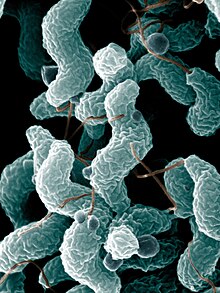
Back عطيفة (بكتيريا) Arabic عطيفه (جنس من بدائيات النوى) ARZ Campilobàcter Catalan Campylobacter Czech Campylobacter Danish Campylobacter German Campylobacter Spanish Campylobacter Basque کامپیلوباکتر Persian Kampylobakteerit Finnish
| Campylobacter | |
|---|---|

| |
| Campylobacter jejuni | |
| Scientific classification | |
| Domain: | Bacteria |
| Phylum: | Campylobacterota |
| Class: | "Campylobacteria" |
| Order: | Campylobacterales |
| Family: | Campylobacteraceae |
| Genus: | Campylobacter Sebald & Véron 1963 |
| Type species | |
| Campylobacter fetus (Smith & Taylor 1919) Sebald & Veron 1963
| |
| Species | |
|
See text | |
Campylobacter is a type of bacteria that can cause a diarrheal disease in people.[1] Its name means "curved bacteria", as the germ typically appears in a comma or "s" shape. According to its scientific classification, it is a genus of gram-negative bacteria that is motile.[a][2]
The germ is common in nature and in domestic animals. It is frequently found in raw food of vegetable and animal origin. Its numbers can be very high in some foods, like raw poultry.[3] Due to their diverse natural reservoir, some Campylobacter can also be detected in the air, although not at an epidemiologically significant level.[4] The disease that some of the species of the bacteria can cause is called campylobacteriosis.[b]
At least a dozen species of Campylobacter have been implicated in human disease, with C. jejuni (80–90%) and C. coli (5–10%) being the most common.[6][1] C. jejuni is recognized as one of the main causes of bacterial foodborne disease in many developed countries.[6][7] It is the number one cause of bacterial gastroenteritis in Europe, with over 246,000 cases confirmed annually.[8] C. jejuni infection can also cause bacteremia in immunocompromised people, while C. lari is a known cause of recurrent diarrhea in children.[9] C. fetus can cause spontaneous abortions in cattle and sheep, and is an opportunistic pathogen in humans.[10]
- ^ a b Blaser, Martin J. (December 1997). "Epidemiologic and Clinical Features of Campylobacter jejuni Infections". The Journal of Infectious Diseases. 176 (s2): S103–S105. doi:10.1086/513780. PMID 9396691.
- ^ Garrity, George M.; Bell, Julia A.; Lilburn, Timothy (2005). "Class V. Epsilonproteobacteria class. Nov.". Bergey's Manual® of Systematic Bacteriology. pp. 1145–1194. doi:10.1007/0-387-29298-5_4. ISBN 978-0-387-24145-6.
- ^ Cite error: The named reference
cazpwas invoked but never defined (see the help page). - ^ Olsen, Katja N.; Lund, Marianne; Skov, Julia; Christensen, Laurids S.; Hoorfar, Jeffrey (2009). "Detection of Campylobacter Bacteria in Air Samples for Continuous Real-Time Monitoring of Campylobacter Colonization in Broiler Flocks". Applied and Environmental Microbiology. 75 (7): 2074–2078. doi:10.1128/AEM.02182-08. ISSN 0099-2240. PMC 2663182. PMID 19201953.
- ^ Skarp CP, Hänninen ML, Rautelin HI (February 2016). "Campylobacteriosis: the role of poultry meat". Clinical Microbiology and Infection. 22 (2): 103–109. doi:10.1016/j.cmi.2015.11.019. PMID 26686808.
- ^ a b Ryan, Kenneth J.; Ray, C. George, eds. (2004). Sherris Medical Microbiology: An Introduction to Infectious Diseases (4th ed.). McGraw Hill. pp. 378–380. ISBN 978-0-8385-8529-0.
- ^ Moore, John E.; Corcoran, Deborah; Dooley, James S.G.; Fanning, Séamus; Lucey, Brigid; Matsuda, Motoo; McDowell, David A.; Mégraud, Francis; Cherie Millar, B.; O'Mahony, Rebecca; O?Riordan, Lisa; O'Rourke, Michele; Rao, Juluri R.; Rooney, Paul J.; Sails, Andrew; Whyte, Paul (May 2005). "Campylobacter". Veterinary Research. 36 (3): 351–382. doi:10.1051/vetres:2005012. PMID 15845230.
- ^ "Campylobacter". European Food Safety Authority. Retrieved 2020-11-02.
- ^ Campylobacter Infections at eMedicine
- ^ Sauerwein, RW; Bisseling, J; Horrevorts, AM (1993). "Septic abortion associated with Campylobacter fetus subspecies fetus infection: case report and review of the literature". Infection. 21 (5): 331–3. doi:10.1007/BF01712458. PMID 8300253. S2CID 28539930.
Cite error: There are <ref group=lower-alpha> tags or {{efn}} templates on this page, but the references will not show without a {{reflist|group=lower-alpha}} template or {{notelist}} template (see the help page).
© MMXXIII Rich X Search. We shall prevail. All rights reserved. Rich X Search